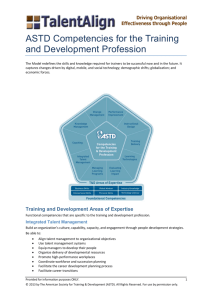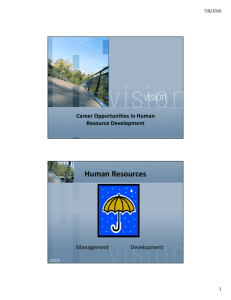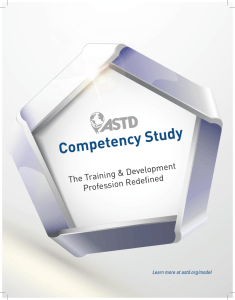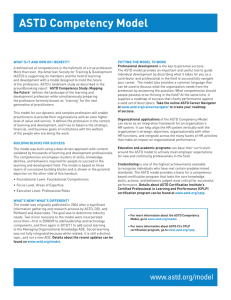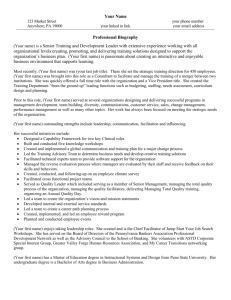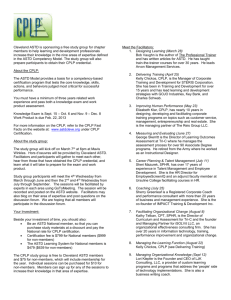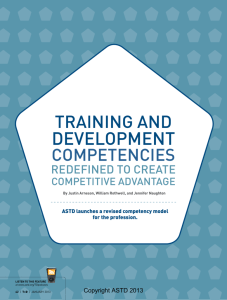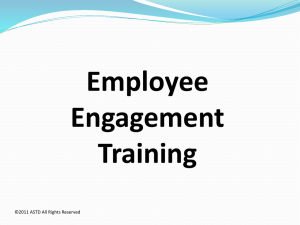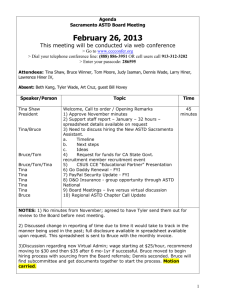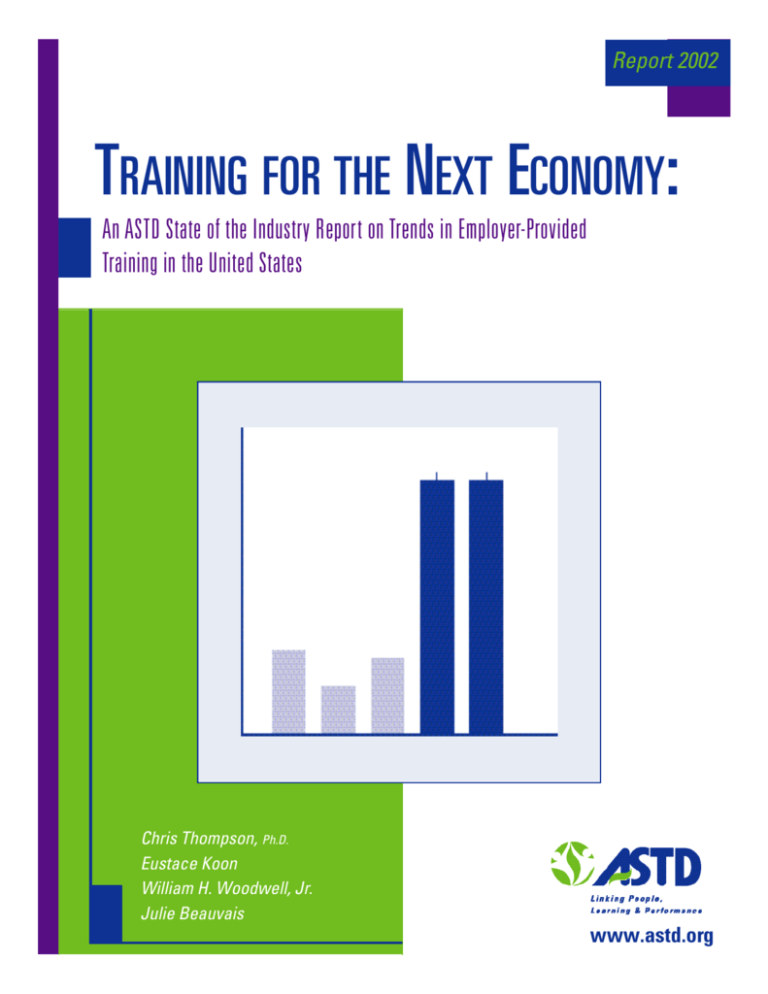
Report 2002
TRAINING FOR THE NEXT ECONOMY:
An ASTD State of the Industry Report on Trends in Employer- P ro v i d e d
Training in the United States
Chris Thompson, Ph.D.
Eustace Koon
William H. Woodwell, Jr.
Julie Beauvais
www.astd.org
✹ An ASTD “Classic” Member Benefit
To purchase additional electronic copies, please visit ASTD’s online bookstore at www.astd.org,
or contact the ASTD Customer Care Center at 7 0 3 . 6 8 3 . 8 1 0 0 or 800.628.2783.
O rdering Information: Product #790201.
All inquiries from members of the media should be directed to Jennifer Homer (jhomer@astd.org/703.683.8123)
Authors:
Chris Thompson, Ph.D., Director of Knowledge Development (cthompson@astd.org)
Eustace Koon, Research Analyst (ekoon@astd.org)
William H. Woodwell, Jr., Special Projects Editor
Julie Beauvais, Research Assistant
Acknowledgements:
The authors would like to thank the following individuals and groups for their assistance in the preparation of this
report: Gale Rossides of the Transportation Security Administration; Elmer Nelson, Elizabeth A. Mangino, and Dr.
Candace Phelan of Lockheed Martin; Samuel M. Pulcrano, Stan Pullen, and Ann Trahan of the United States Postal
Service; David Browning of Training Futures; Yvonne Kassimatis, Nhu Mai Le, and Linh Truong of ASTD Creative
Services; members of the ASTD Research-to-Practice Committee; members of the ASTD Friends Network; and ASTD
colleagues Tina Sung, Cynthia Pantazis, Pat Galagan, Haidee Allerton, Pam Sharpe, and Jennifer Homer. Finally, our
thanks to Dr. Mark Van Buren for developing the foundation in previous editions.
Copyright © December 2002 ASTD. All rights reserved. No part of this work covered by the copyright hereon may be
reproduced or used in any form or by any means—graphic, electronic, or mechanical (including photocopying, recording, taping, or via information storage and retrieval systems)—without written permission from the publisher.
TRAINING FOR THE NEXT ECONOMY:
An ASTD State of the Industry Report on Trends in Employer-Provided
Training in the United States
Chris Thompson, Ph.D.
Eustace Koon
William H. Woodwell, Jr.
Julie Beauvais
www.astd.org
Training for the Ne x t Economy: An ASTD State of the In d u s t ry Re p o rt
Welcome to Training for the
Next Economy — the sixth annual report
in the ASTD State of the Industry series!
This report gives a window onto a learning and performance world starting to come to terms
with the dual shocks of 9/11 and recession. I am delighted that our findings from ASTD
Benchmarking Service organizations show workplace learning and performance is holding its
own and evolving in this uncertain "Next Economy." Training expenditures as a percent of
payroll have not markedly declined but are within the range of fluctuation experienced before
2001. The training dollars invested per employee, the share of the workforce receiving training,
and the use of learning technologies are all higher than before. We know we are in a knowledge
economy where the skills and abilities that make up an organization’s human capital are the
greatest asset. What has changed is that there is now a heightened emphasis on linking learning
with performance and business results, and a greater need to be able to demonstrate that.
I invite you to digest all the findings in this report, and reflect upon their implications for
your own organization and practice if you are a learning-for-performance professional, or for
your products and services if you are a supplier or developer. In the Next Economy, will you be
called upon to train more people, in more places, at a faster pace, with shorter notice and fewer
resources? Will you be turning increasingly to technology to help you succeed? Will you have to
justify in hard business terms every extra dollar and body devoted to training? The findings in
this report strongly suggest you will. If so, please, do not hesitate to let me know how ASTD
might help—through our benchmarking services, our leading edge content, our ASTD
networks, and our outstanding dedicated communities of learning-for-performance professionals.
Sincerely,
Tina Sung
President and CEO
American Society for Training and Development (ASTD)
2
Training for the Ne x t Economy: An ASTD State of the In d u s t ry Re p o rt
Executive Summary
About this Report
Training for the Next Economy: An ASTD State of the Industry Report continues ASTD’s
tradition of compiling and providing the most comprehensive set of statistics available regarding
employer-provided workplace learning in the United States. This report builds on findings in the
2002 ASTD State of the Industry Report by providing information on training trends during the
2001 calendar year, by attempting to set them in the context of wider changes resulting from
9/11 and recession, and by extending its scope into a qualitative review of the key lessons for the
workplace learning and performance community from "the training stories" of 2001/2002.
About the ASTD Benchmarking Service and ASTD Benchmarking Forum
The ASTD State of the Industry Report series is based on data from ASTD’s Benchmarking
Service online Measurement Kit, which collects information from all types of organizations on
the nature of their training investments and practices. This report analyzes findings from 270
U.S. organizations that input their 2001 data, along with aggregate findings from the annual
survey of members of ASTD’s Benchmarking Forum, the leading venue for world-class
organizations to benchmark and share information on their workplace learning and performance
improvement strategies, processes, and best practices.
Key Findings
Training holds its own with changes in method. Despite recession and the events of 9/11,
organizations entering their data into the ASTD Benchmarking Service did not, on average,
report any marked changes in their training investments and activities between 2000 and 2001.
The bulk of any changes may yet appear in subsequent data, but differences in projections for
the future made by respondents before and after 9/11 suggest that events served to enhance
previous trends, and in particular the shift to e-learning.
The spending picture is mixed. Training
expenditures dropped from 2.0 percent of payroll in
2000 to 1.9 percent of payroll in 2001, which is a
reversal of the upward trend found between 1999 and
2000 but still within the range of values exhibited in
recent years. Training expenditures per eligible
employee rose 8 percent to $761, but the share of
eligible employees receiving training (78 percent) and
their average hours (23.7) were both very close to last
year’s numbers.
The ASTD Key Ratios for Benchmarking Service
Organizations in 2001
Total Training Expenditures per Training-Eligible Employee:
Total Training Expenditures as % of Payroll:
$761
1.9
Percent of Training-Eligible Employees Trained:
78.5
Training-Eligible Employees to Trainer Ratio:
367
Percent of Training Time via Classroom:
77.1
Percent of Training Time via Learning Technologies:
E-learning reaches record level while classroom
share declines. Over the last several years, the
Payments to Outside Companies as % of Total Training Expenditures:
percentage of training time delivered via learning
Total Training Hours per Training-Eligible Employee:
technologies in Benchmarking Service companies has
held steady at between 8.5 and 9.1 percent. In 2001,
this share increased to 10.5 percent, and the share of
expenditures that went to learning technologies increased from 3.7 to 4.6 percent. Conversely,
the percentage of training time delivered via the classroom declined slightly, from 79.4 percent
in 2000 to 77.1 percent in 2001. Technology may be finding its niche as the solution for the
problem of how to do more with less in the “Next Economy.”
10.5
20.9
23.7
3
Training for the Ne x t Economy: An ASTD State of the In d u s t ry Re p o rt
Evaluation remains a challenge. More organizations than ever before are conducting some
kind of evaluation of training, and more are attempting the higher levels of evaluation. Yet still
only about one in ten organizations are attempting any results-based (Level 4) evaluation.
Training Investment Leaders aren’t just running faster; they’re working smarter. ASTD
identifies the top 10 percent of all Benchmarking Service participants as Training Investment
Leaders on the basis of their training investments, time, reach, and sophistication. By definition,
members of this group have made a significant commitment to developing the abilities of their
employees, and are leading the rest of the pack. Interestingly, this year’s data show that the
Training Investment Leaders are distinguished not only by their levels of investment and training
– they spend about twice as much per eligible employee as the Benchmarking Service average
and provide more than double the training hours —but also by their differences in emphasis and
practice. For example, they are spending a greater share of their training money on front-line
supervisors and senior managers, and a smaller share on administrative employees, relative to the
larger group. In the area of human performance management, they appear to be moving away
from individual development plans, skill certification, and documentation of individual
competencies. As for work practices, they are more likely to use self-directed work teams than
the rest of the group. They also now place less emphasis on traditional "Reaction" (Level 1)
methods of evaluation, and are more likely to attempt the higher levels of evaluation.
The outsourcing pendulum swings again. Previous reports found payments to outside
training companies as a percentage of total training expenditures were on the rise (from 19.9
percent of training expenditures in 1999 to 22.2 percent in 2000) after an earlier period of
decline. Figures for 2001 show a slight decline once again, to 20.9 percent. When outsourcing,
Benchmarking Service and Training Investment Leader organizations make more use of 4-year
colleges and universities, and community and junior colleges, while Benchmarking Forum
companies make more use of private training and consulting companies and contractors.
9/11-connected training events hold important lessons for the workplace learning and
performance community. Comparison of statistical projections made by respondents before and
after 9/11 indicated no dramatic changes in employees to be trained and levels of spending, but
that pre-existing shifts to e-learning are likely to be enhanced. To get a better sense of the
"training picture" in the wake of 9/11 and recession, ASTD interviewed key players in three
training initiatives carried out in the aftermath of the terrorist attacks. These included: the
federal government’s effort to hire and train 32,000 passenger screeners to staff airport security
checkpoints; the U.S. Postal Service’s nationwide training initiative aimed at preventing deaths
and infections from anthrax-laced mail; and a small nonprofit organization’s efforts to help
workers dislocated by the Pentagon attack as they shift from New Economy to Next Economy
work. Among the lessons learned from these stories are:
1. The stimulus for new thinking and new training approaches can come anytime and from
anywhere, without warning. You only get one chance to make a first response.
2. Basic training principles can and should be applied in the modern context.
3. Customer focus is an important element of all training, even if the real substance of the training
addresses a more specific problem.
4. Successful modern training and development has to be about more than curriculum and
content, and extend its reach to the whole person, building the capacity to learn along with
personal resilience. It’s not just about the next job: it’s about the Next Economy.
5. Technology is more than just a useful tool. It is now central to initial assessment, training
delivery and consistency, going to scale, and whole-system preparedness.
4

